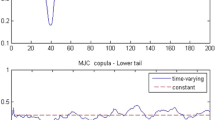Abstract
The effects of the Boxing Day tsunami on the world equity markets are investigated in this paper. In particular, this paper examines how the risks and returns of industry and market portfolios are altered as a result of the tsunami. The analysis includes countries that were directly or indirectly exposed to this catastrophe. Both parametric and non-parametric tests are employed to explore the relationship between equity stock returns and the tsunami, and the CAPM is utilised to assess the variation in systematic risks. Given that the literature in this area is at its earliest stage, we draw on economic theories of flooding. In this way, our results are consistent with that of the flooding literature, which would predict that the Boxing Day tsunami would have minimal effects on the risks and returns of equity markets. This paper documents that the tsunami was associated with few abnormal return changes and a general increase in the long-term systematic risk of the equity portfolios in the study.
Similar content being viewed by others
Notes
We attempted to collect data for Bangladesh and Kenya. Given the poor quality of these data, it was not possible to use them in our study. The poor quality is predominantly the result of the old technology that is used to store the data.
Note that we do not report the results of the Wald test in this paper.
Generally, when the reported non-parametric t-statistics are less (greater) than negative (positive) two, we conclude that the abnormal returns were negative (positive) on the day of the event. Note that this test provides only the direction of change; it does not inform us about the magnitude of change.
References
Bandara J, Naranpanawa A (2007) The economic effects of the Asian tsunami on the tear drop in the Indian Ocean. South Asia Econ J 8(1):65–85
Barro RJ (2006) Rare disasters and asset markets in the twentieth century. Quart J Econ 121:823–866
Binder J (1998) The event study methodology since 1969. Rev Quant Financ Acc 11(2):111–137
Bird M, Cowie S, Hawkes A, Horton B, Macgregor C, Ong JE, Hwai ATS, Sa TT, Yasin Z (2007) Indian Ocean tsunamis: environmental and socio-economic impacts in Langkawi, Malaysia. Geogr J 173:103–117
Bremer R, Buchanan B, English P (2011) The advantages of using quarterly returns for long-term event studies. Rev Quant Financ Acc 36(4):491–516
Brown SJ, Warner JB (1985) Using daily stock returns: the case of event studies. J Financ Econ 14(1):3–31
Cam M (2008) The impact of terrorism on United States industries. Econ Papers (Econ Soc Aust) 27(2):115–135
Corrado CJ (1989) A non-parametric test for abnormal security price performance in event studies. J Financ Econ 23:385–395
Corrado CJ, Truong C (2008) Conducting event studies with Asia-Pacific security market data. Pac-Basin Financ J 16:493–521
Dasgupta S, Laplante B, Mamingi N (2001) Pollution and capital markets in developing countries. J Environ Econ Manage 42:310–335
Dasgupta S, Hong JH, Laplante B, Mamingi N (2006) Disclosure of environmental violations and stock market in the Republic of Korea. Ecol Econ 58:759–777
Du D, Denning K, Zhao X (2011) Evidence on stock reaction to market-wide information. Rev Pac Basin Financ Markets Policies 14(2):297–325
Graham M, Ramiah V (2012) Global terrorism and adaptive expectations in financial markets: evidence from Japanese equity market. Res Int Bus Financ 26(1):97–119
Ichinosawa J (2006) Reputational disaster in Phuket: the secondary impact of the tsunami on inbound tourism. Disaster Prev Manag 15(1):111–123
Kahn M (2005) The death toll from natural disasters: the role of income, geography, and institutions. Rev Econ Stat 87(2):271–284
Keys A, Masterman-Smith H, Cottle D (2006) The political economy of a natural disaster: the Boxing Day tsunami. Antipode 38(2):195–204
Laplante B, Lanoie P (1994) The market response to environmental incidents in Canada: a theoretical and empirical analysis. South Econ J 60:657–672
Lee H, Wu H, Wang Y (2007) Contagion effect in financial markets after the South-East Asia Tsunami. Res Int Bus Financ 21:281–296
Palmon D, Sudit E, Yezegel A (2009) The value of columnists stock recommendations: an event study approach. Rev Quant Financ Acc 33(3):209–232
Ramiah V, Cam M, Calabro M, Maher D, Ghafouri S (2010) Changes in equity returns & volatility across different Australian industries following the recent terrorist attacks. Pac -Basin Financ J 18(1):64–76
Raschky P (2008) Institutions and the losses from natural disasters. Nat Hazards Earth Syst Sci 8:627–634
Rietz TA (1988) The equity risk premium a solution. J Monet Econ 22(1):117–131
Roll R (1988) The international crash of October 1987. In: Kamphius R, Kormendi R, Waston J (eds) Black Monday and the future of financial markets. Mid-American Institute, Oklahoma
Strömberg D (2007) Natural disasters, economic development, and humanitarian aid. J Econ Perspect 21(3):199–222
Toya H, Skidmore M (2007) Economic development and the impact of natural disasters. Econ Lett 94:20–25
Worthington A, Valadkhani A (2004) Measuring the impact of natural disasters on capital markets: an empirical application using intervention analysis. Appl Econ 36:2177–2186
Yen G, Lee C (2008) Efficient market hypothesis (EMH): past, present and future. Rev Pac Basin Financ Markets Policies 11(2):305–329
Acknowledgments
Gemma Cascio, Gillian Martin, Lan Tran, Monica Polec, Ng Ngar Ling, Rohit Tharani, Catherine Romeo, Daniel Di Stefano, Daniel Torre, Naomi Wijeyesekera, Peter White, Pravna Appadoo, Ryan Hughes, Marcel Madalin and Simon Lan are the other researchers involved in this research project. An earlier version of this paper was presented at the RMIT Finance Seminar 2010 and the Asian Finance Association Conference 2011, and we wish to thank the participants (in particular, Richard Heaney, Sinclair Davidson, Tim Fry, Lisa Farell, Lurion De Mello, Alberto Posso, Imad Moosa, Cheng-Few Lee, and two anonymous reviewers) for their helpful comments and support. It is also important to recognise Tseen-Ling Khoo for her editorial support.
Author information
Authors and Affiliations
Corresponding author
Rights and permissions
About this article
Cite this article
Ramiah, V. Effects of the Boxing Day tsunami on the world capital markets. Rev Quant Finan Acc 40, 383–401 (2013). https://doi.org/10.1007/s11156-012-0286-z
Published:
Issue Date:
DOI: https://doi.org/10.1007/s11156-012-0286-z




